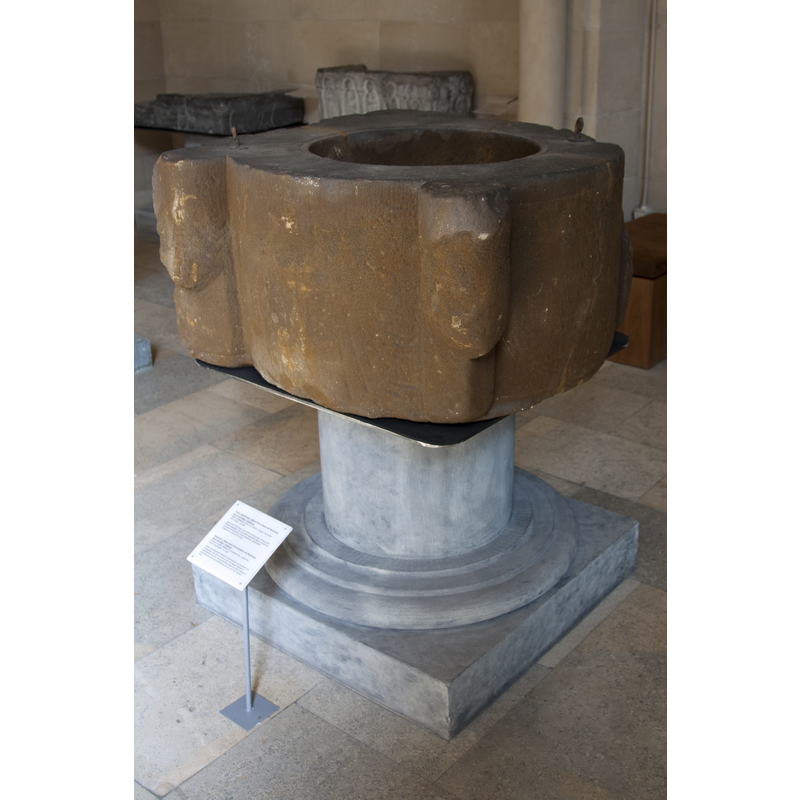Brussels No. 8 / Bruxelles

Image copyright © José Antonio Tolosa Urieta, 2010
Standing permission
Results: 3 records
view of basin
Scene Description: notice the unfinished side and heads [cf. Font notes]
Copyright Statement: Image copyright © José Antonio Tolosa Urieta, 2010
Image Source: digital photograph taken 27 April 2010 by José Antonio Tolosa Urieta [www.infomolina.com] for BSI
Copyright Instructions: Standing permission
view of basin
Scene Description: notice the damaged sections: the vertical cracks, and the broken angle protrusion where one head would have been carved [cf. Font notes]
Copyright Statement: Image copyright © José Antonio Tolosa Urieta, 2010
Image Source: digital photograph taken 27 April 2010 by José Antonio Tolosa Urieta [www.infomolina.com] for BSI
Copyright Instructions: Standing permission
view of font
INFORMATION
FontID: 16535BRU
Object Type: Baptismal Font1
Museum and Inventory Number: Musées royaux d'art et d'histoire de Bruxelles / Koninklijke Musea voor Kunst en Geschiedenis - Brussel
Church/Chapel: Eglise Notre-Dame de Berbroek / Onze-Lieve-Vrouw Geboortekerk
Church Patron Saints: St. Mary the Virgin
Country Name: Belgium
Location: Bruxelles, Région de Bruxelles-Capitale / Brussels Hoofdstedelijk Gewest ou Brussel
Directions to Site: Located in Herk-de-Stad [Coordinates: 50°57'N 5°12'E]
Font Location in Church: In a Brussels museum
Century and Period: 12th - 13th century, Late Romanesque
Workshop/Group/Artisan: atelier brabançon
Credit and Acknowledgements: We are grateful to José Antonio Tolosa Urieta, of www.infomolina.com, for his photographs of this font
Font Notes:
Click to view
Basin made of a ferruginous sandstone [the museum label identifies the stone as limestone "grès distien" ['grès tertiaire à ciment ferrugineux' from Diest, Belgium], the unfinished work of a Brabant workshop] of a common design of this period and place: from a square plan, the main body of the basin is round, practically cylindrical, and the angles are usually carved into human heads; in this case the carving was not completed, so we can see the stages in which this type of font was produced; three sides are roughed out and the angles are ready to have the finer carving work done; the fourth side, however, is still rough; the metal staples for the cover are in place, which may indicate the font was used even though never completed. The pedestal base on which is is displayed in the museum is modern. [NB: one of the rounded protrusions were the heads are usually carved is broken, the damage may be related to the initial setting of one of the cover staples, as the one in that spot appears to be drilled in a receded distance in comparison with the other; be that as it may, the damage led the masosn to abandon the piece; it is possible that they smashed the basin -notice the breakage lines where the font has been repaired- and abandoned].
MEDIUM AND MEASUREMENTS
Material: stone, sandstone (grès distien)
Font Shape: round (with heads) (mounted)
Basin Interior Shape: round
Basin Exterior Shape: round (with heads)
LID INFORMATION
Notes: [cf. FontNotes]
![notice the unfinished side and heads [cf. Font notes]](/static-50478a99ec6f36a15d6234548c59f63da52304e5/compressed/1100515002_compressed.png)
![notice the damaged sections: the vertical cracks, and the broken angle protrusion where one head would have been carved [cf. Font notes]](/static-50478a99ec6f36a15d6234548c59f63da52304e5/compressed/1100516005_compressed.png)